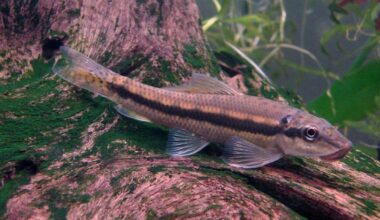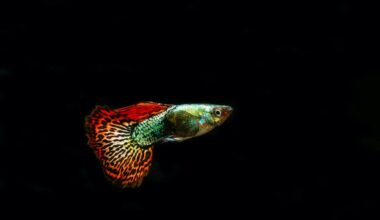Diamond tetras are gorgeous freshwater fish that don’t get nearly enough attention. We’ve been fans of this species for years, and definitely recommend them to anyone!
They’re beautiful, easy to care for, and a lot of fun to watch. This makes them a great beginner fish. However, this is a great choice if you have experience and just want a low-maintenance freshwater species as well.
In this guide we’ll go over the fundamentals of diamond tetra care to help you get prepared for ownership. You’ll learn everything you need to know!
Table of Contents
Species Summary
The diamond tetra (scientific name: Moenkhausia pittieri) is an eye-catching species that goes by many other names. It’s sometimes called the diamond characin, or the timanttitetra. Whatever you choose to call it, there’s no denying this freshwater fish’s beauty.
Originally from inland bodies of water in South America, the diamond tetra prefers to live in shallow and slow-moving tributaries. These fish are typically found in the Rio Bue, Rio Tiquiriti, and Lake Valencia.
Like other fish from this region, the diamond tetra does very well in captivity. It’s a common sight in the pet trade and continues to be a favorite among fish-lovers around the globe.
Appearance
The diamond tetra is one of the stockier types of tetras out there. It’s a bit larger than most tetras, but it still features the same laterally compressed body.
The fish gets its common name from the gorgeous finish of its scales. Most of the body takes on a silvery hue. However, the scales have an iridescent shimmer than can flash colors of orange, blue, green, and gold! The iridescent finish gets more vibrant as the fish ages, reaching its pinnacle once the fish matures.

The fins are usually semi-transparent and have a subtle violent tone. Like other tetra species, the diamond tetra has a lengthy anal fin. The dorsal fin is deserving of some special attention, too.
For females, the dorsal fin is quite short. Meanwhile, males have long and pointed fins that are easy to identify. As a result, this species has relatively clear-cut sexual dimorphism, which comes in handy during the breeding season.
One final noteworthy characteristic of the diamond tetra is the eyes. The eyes feature a subtle splash of red on the upper half, creating a unique accent.
Author Note: While this might not seem like much, it really stands out (even when these fish are swimming around). It really adds to their overall beauty!
Average Diamond Tetra Size
The average diamond tetra size is about 2 to 2.4 inches in length for adults. That makes them quite small and easy to manage even if you don’t have space for a larger aquarium.
We think this size makes them even more fun to spectate. They look like tiny glimmering torpedoes shooting around the tank.
Lifespan
The average diamond tetra lifespan is anywhere between three and six years in captivity. However, there are never any guarantees when it comes to the lifespan of a fish (as you probably know).
Author Note: The quality of care you provide will have a big impact on the lifespan of these freshwater fish. While hardy, diamond tetras still need a well-maintained environment and top-notch diet to stave off disease and stay healthy.
Diamond Tetra Care
For the most part, diamond tetra care is fairly straightforward. These freshwater fish are surprisingly resilient, which makes them great options for beginners and novice aquarists alike.
But as always, there are some important care guidelines to follow if you want to help your fish thrive and reach their full potential! Once you become familiar with their requirements, owning them will be a piece of cake.
Tank Size
The first thing to consider? The size of your tank!
Diamond tetras are on the smaller end of the size spectrum when it comes to freshwater fish. We recommend a tank size of at least 15 gallons when keeping these fish. That should be enough to keep a smaller group of three fish.
That said, more space is never a bad thing. These little creatures are peaceful, but they can also be very active. A larger tank will create more swimming space while also making it easier to maintain water conditions.
Water Parameters
Speaking of water conditions, it’s important to create the right environment for your fish when it comes to parameters..
Diamond tetras come from shallow rivers and streams in South America, and prefer warm waters that are slightly neutral. This species can survive in alkaline waters thanks to their hardy nature, but slight acidity can do a lot to help bring out their beauty!
Below are the main water parameters to aim for.
- Water temperature: 72°F to 82°F (around 75 to 76 degrees is ideal)
- pH levels: 6.0 to 7.5 (aim for a touch below neutral)
- Water hardness: 4 to 8 KH
Author Note: Make sure you go out and purchase an aquarium test kit that’s reliable and accurate. This will be your lifeline when it comes to monitoring the state of your tank and knowing what adjustments to make.
Setting Up The Inside Of Their Tank
When you’re decorating the tank, aim to replicate their natural habitat as closely as possible. Diamond tetras do best in an Amazonian biotope setup. That means they’re used to living in environments that are teeming with plant life, so do your best to achieve something similar.
Start off with a layer of sand substrate. Diamond tetras aren’t going to venture down there too much, but it helps provide that natural feel. Add some driftwood and twisting branches to simulate all of the hiding places the fish have in the wild.

Now, add live plants. Feel free to get creative here since there are no hard requirements in terms of plant cultivars. Mix and match foreground plants, tall stem plants, and floating plants.
The goal here is to give the fish plenty of places to hide and relax. The plants need to provide adequate shelter from the light, as these fish do not like bright lights.
Diamond tetras do fine with standard filtration systems. You can utilize hang-on-back models or canister models. Whatever you choose, make sure that it can cycle the water volume several times an hour to keep ammonia and nitrate levels undetectable.
Common Possible Diseases
For diamond tetras, suffering from a disease isn’t normally a huge issue. This is a hardy species that can withstand a lot before succumbing to health problems (which is another reason why they’re great for beginners).
That said, no fish are immune to disease! Diamond tetras suffer from all of the common freshwater ailments. Some common issues to look out for include ich, parasitic infections, bacterial diseases, and more.
Fortunately, most of the common diseases are easy to avoid if you stay on top of water conditions.
Monitor water parameters regularly. Additionally, perform a 25 to 50 percent water change every other week.
Author Note: The great thing about diamond tetras is that their hardiness often limits the spread of disease. As long as you catch the problem early on, you can quarantine the fish and mitigate the spread to others in the community.
Food & Diet
Diamond tetras are easy to please! These fish are natural omnivores that will eat everything from plant matter to tiny insects in the wild. They aren’t picky, so finding suitable meals should be a cinch!
Dry flakes or pellets should be the main diet staple. Choose a balanced formula that meets their nutritional needs. You can also go for a product with vitamins that bring out the fish’s natural coloration.
Occasional plant and protein-based snacks are good, too! For vegetables, diamond tetras like simple snacks like lettuce. For protein, go for dried, freeze-dried, or live foods. They are particularly fond of brine shrimp, daphnia, and bloodworms.
Behavior & Temperament
If you’re looking for a peaceful community fish that can cohabitate with others, the diamond tetra is an excellent choice! A schooling fish, diamond tetras prefer to stay with a small group.
Interestingly enough, they like odd-numbered social groups. At the very least, keep three fish together. However, five or seven is even better!
These fish will group up throughout the day to explore the tank and scavenge for food. You might see some playful fighting here and there, but aggression is usually not something you have to worry about with diamond tetras.
Tank Mates
Diamond tetras make great additions to larger multi-species tanks. However, you have to put a bit of thought into its tank mates.
You should never keep these guys with super-aggressive species. Larger fish are out of the question, too. They can quickly become food to larger species!
Many owners have seen success using diamond tetras as dither fish for medium-sized cichlids. But we don’t recommend trying that out unless you have some experience.
Instead, stick to peaceful fish that are roughly the same size as this species. Here are some good diamond tetra tank mates to try out:
Author Note: Shrimp are a tank mate to avoid if you have a diamond tetra. These fish will definitely view your shrimp as a snack!
Breeding
Breeding diamond tetras can be hit or miss! The biggest challenge that aquarists have to overcome is pairing the fish off.
These fish can be a bit picky in that regard. They will only spawn with other fish of the same size and age. So, it may take some trial and error to get things right. But once you do, it’s smooth sailing from there.
It’s best to breed diamond tetras in a separate tank that’s about 20 gallons in size. Make the pH level slightly more acidic. Also, keep the hardness low.
Add some spawning mops or clumps of java moss to the bottom of the tank. Diamond tetras are egg-layers. Once the female releases the eggs, they will fall into the mops to stay protected from hungry adults.
Turn all of the lights off in the tank and add your fish. You can breed them in single pairs or larger groups of 12. Once all of the fish are in, slowly raise the light level. This should induce spawning.
The females will release their eggs while the males fertilize them. After all the fish are done spawning, remove the adults!
Eggs should hatch in about 24 to 36 hours. The fry will survive on the egg sac for a few days more. After they become free-swimming, provide fry food, such as infusoria or baby brine shrimp.
The young fish will have duller coloration than their adult counterparts. But, the iconic iridescent shimmer will start to develop at about nine months of age.
Conclusion
Diamond tetras are a fascinating freshwater fish that more owners should consider. With their incredibly beauty and low-maintenance care requirements, this is a species that anyone can enjoy!
If you have any lingering questions about diamond tetra care that weren’t answered in this guide, feel free to send them our way. We’re more than happy to help!

